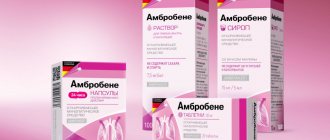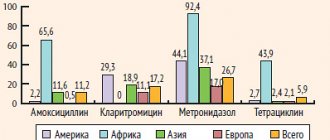What is Lazolvan
A medicine based on the active substance ambroxol hydrochloride. Designed to liquefy viscous mucous secretions and remove them from the lungs. The product is produced in several forms:
- inhalation solution: transparent light brown liquid containing 7.5 mg of ambroxol, in 100 ml bottles with dispensers and measuring cups;
- tablets for oral administration: round, yellowish, 30 mg each, in blisters with cells of 10 pcs.;
- children's syrup: viscous transparent liquid of a sweetish taste containing 15 mg of ambroxol, bottles of 100–200 ml;
- medicinal lozenges for resorption: brown, mint-scented, contain 15 mg of active ingredient.
Side effect
From the digestive system:
often (1-10%) - nausea; infrequently (0.1-1%) - dyspepsia, vomiting, diarrhea, abdominal pain.
From the immune system, from the skin and subcutaneous tissues:
rarely (0.01-0.1%) - rash, urticaria; angioedema*, anaphylactic reactions (including anaphylactic shock)*, itching*, hypersensitivity.
* these adverse reactions were observed with widespread use of the drug; with a 95% probability, the frequency of these adverse reactions is uncommon (0.1%-1%), but possibly lower; the exact frequency is difficult to estimate, because they were not noted in clinical studies.
How Lazolvan works
The medicine increases the volume and production of secretions, promoting its liquefaction, stimulates the work of epithelial cilia, helping to move phlegm out. The effect of aerosol particles of the drug begins 20–30 minutes after inhalation. After oral administration, the active substance begins to function within 2–3 hours.
The therapeutic effect lasts from 6 to 12 hours. The components of the drug are metabolized in the liver and leave the body within 10–15 hours. They do not accumulate in blood and tissues.
Pharmacokinetics
Suction and distribution
All dosage forms of immediate release ambroxol are characterized by rapid and almost complete absorption with a linear dose dependence in the therapeutic concentration range. Cmax in plasma is achieved after 1-2.5 hours. The absolute bioavailability of Lazolvan® 30 mg tablets is 79%.
Vd is 552 l. In the therapeutic concentration range, binding to plasma proteins is approximately 90%. The transition of ambroxol from the blood to tissues when administered orally occurs quickly. The highest concentrations of the active component of the drug are observed in the lungs.
Metabolism and excretion
Approximately 30% of an administered oral dose undergoes first-pass effects through the liver. Studies in human liver microsomes have shown that CYP3A4 is the predominant isoform responsible for the metabolism of ambroxol to dibromoantranilic acid. The remainder of ambroxol is metabolized in the liver, mainly by glucuronidation and by partial breakdown to dibromanthranilic acid (approximately 10% of the administered dose), as well as a small number of additional metabolites.
The terminal half-life of ambroxol is about 10 hours. The total clearance is within 660 ml/min, renal clearance accounts for approximately 8% of the total clearance.
Using the radioactive tracer method, it was calculated that after taking a single dose of the drug, about 83% of the dose taken is excreted in the urine over the next 5 days.
No clinically significant effect of age and gender on the pharmacokinetics of ambroxol was found, so there is no basis for selecting the dose based on these characteristics.
For what diseases is Lazolvan needed?
The medicine is indicated for use:
- for pneumonia;
- acute and chronic bronchitis;
- asthma with difficulty producing sputum;
- bronchial obstruction;
- respiratory distress syndrome;
- other pathologies of the respiratory tract, accompanied by excessive secretion synthesis.
Lazolvan improves well-being and makes breathing easier, but does not affect pathogens. It can only be used as a symptomatic remedy.
pharmachologic effect
Mucolytic and expectorant drug.
Studies have shown that ambroxol increases secretion in the respiratory tract. It enhances the production of pulmonary surfactant and stimulates ciliary activity. These effects lead to increased mucus flow and transport (mucociliary clearance). Increasing mucociliary clearance improves sputum discharge and relieves cough.
In patients with COPD, long-term therapy with Lazolvan® (for at least 2 months) led to a significant reduction in the number of exacerbations. There was a significant decrease in the duration of exacerbations and the number of days of antibiotic therapy.
How to use Lazolvan to treat children
For coughs and other respiratory tract lesions in children under 6 years of age, use the drug in syrup:
- children under 2 years of age: 2–2.5 ml twice a day;
- at 3–6 years: 3 ml, repeating the dose twice;
- from 6 to 12 years: 5 ml up to three times a day.
Adolescents over 12 years of age are allowed to consume 10 ml of syrup 2-3 times a day.
From the age of 6, you can give children lozenges: 1–2 pieces. three times a day. All forms of Lazolvan are compatible with food. Gastric juice does not affect the effect of the drug. During treatment, it is important to give your child plenty of fluids to drink. It is necessary for better separation of sputum.
Buy Lazolvan solution for internal use and for inhalation 7.5 mg/ml 100 ml in pharmacies
Brief description Lazolvan is a secretomotor, secretolytic, expectorant.
Pharmacological action Mucolytic and expectorant drug. Studies have shown that ambroxol, the active ingredient in Lazolvan®, increases secretion in the respiratory tract. Enhances the production of pulmonary surfactant and stimulates ciliary activity. These effects lead to increased mucus flow and transport (mucociliary clearance). Increasing mucociliary clearance improves sputum discharge and relieves cough. In patients with COPD, long-term therapy with Lazolvan® (for at least 2 months) led to a significant reduction in the number of exacerbations. There was a significant decrease in the duration of exacerbations and the number of days of antibiotic therapy.
Indications Acute and chronic diseases of the respiratory tract, accompanied by the release of viscous sputum and impaired mucociliary clearance: - acute and chronic bronchitis; - pneumonia; - COPD; - bronchial asthma with difficulty in sputum discharge; - bronchiectasis.
Directions for use and dosage: Oral administration (1 ml = 25 drops). Drops can be diluted in water, tea, juice or milk. The solution can be used regardless of meals. Adults and children over 12 years old - 4 ml (100 drops) 3 times a day; children aged 6 to 12 years - 2 ml (50 drops) 2-3 times a day; children aged 2 to 6 years - 1 ml (25 drops) 3 times a day; children under 2 years of age - 1 ml (25 drops) 2 times a day. Inhalations Adults and children over 6 years old - 1-2 inhalations of 2-3 ml of solution/day. Children under 6 years of age: 1-2 inhalations of 2 ml of solution/day. Lazolvan® solution for inhalation can be used using any modern equipment for inhalation (except steam inhalers). To achieve optimal hydration during inhalation, the drug is mixed with 0.9% sodium chloride solution in a 1:1 ratio. Since during inhalation therapy a deep breath can provoke a cough, inhalations should be carried out in normal breathing mode. Before inhalation, it is usually recommended to warm the inhalation solution to body temperature. Patients with bronchial asthma are recommended to carry out inhalation after taking bronchodilators to avoid nonspecific irritation of the respiratory tract and their spasm. If symptoms of the disease persist within 4-5 days from the start of using the drug, it is recommended to consult a doctor.
Side effects From the digestive system: often (1-10%) - dysgeusia (impaired sense of taste), nausea, decreased sensitivity in the oral cavity or pharynx; infrequently (0.1-1%) - dyspepsia, vomiting, diarrhea, abdominal pain, dry mouth; rarely (0.01-0.1%) - dry throat. From the skin and subcutaneous tissues: rarely (0.01-0.1%) - rash, itching*. Allergic reactions: rarely (0.01-0.1%) - urticaria; anaphylactic reactions (including anaphylactic shock)*, angioedema*, hypersensitivity*. * - these adverse reactions were observed with widespread use of the drug; with a 95% probability, the frequency of these adverse reactions is uncommon (0.1%-1%), but possibly lower; the exact frequency is difficult to estimate, because they were not noted in clinical studies.
Contraindications - first trimester of pregnancy; - lactation period (breastfeeding); - hypersensitivity to ambroxol or other components of the drug. Caution should be used in the second and third trimesters of pregnancy, in patients with renal and/or liver failure. Overdose Specific symptoms of overdose in humans have not been described. There have been reports of accidental overdose and/or medical error resulting in symptoms of known side effects of Lazolvan®: nausea, dyspepsia, vomiting, diarrhea, abdominal pain. Treatment: provocation of vomiting, gastric lavage in the first 1-2 hours after taking the drug, symptomatic therapy.
Special instructions Should not be used in combination with antitussives that impede the removal of sputum. The solution contains the preservative benzalkonium chloride, which, when inhaled, may cause bronchospasm in sensitive patients with increased respiratory tract reactivity. Lazolvan® solution for oral administration and inhalation is not recommended to be mixed with cromoglycic acid and alkaline solutions. An increase in the pH value of the solution above 6.3 may cause precipitation of ambroxol hydrochloride or the appearance of opalescence. Patients on a low-sodium diet should take into account that Lazolvan® solution for oral administration and inhalation contains 42.8 mg of sodium in the recommended daily dose (12 ml) for adults and children over 12 years of age. There are isolated reports of severe skin lesions (Stevens-Johnson syndrome and toxic epidermal necrolysis) that coincided with the use of expectorants such as ambroxol hydrochloride. In most cases, they are explained by the severity of the underlying disease and/or concomitant therapy. Patients with Stevens-Johnson syndrome or toxic epidermal necrolysis may present with fever, body aches, rhinitis, cough, and sore throat in the early phase. With symptomatic treatment, it is possible to erroneously prescribe anti-cold medications. If new lesions of the skin and mucous membranes develop, the patient should stop treatment with ambroxol and immediately seek medical help. If renal function is impaired, Lazolvan® should be used only on the recommendation of a doctor. Effect on the ability to drive vehicles and operate machinery. There were no cases of the drug influencing the ability to drive vehicles or operate machinery. Studies on the effect of the drug on the ability to drive vehicles and engage in other potentially hazardous activities that require increased concentration and speed of psychomotor reactions have not been conducted.
Interaction with other drugs No clinically significant, undesirable interactions with other drugs have been reported. Ambroxol increases the penetration of amoxicillin, cefuroxime, and erythromycin into the bronchial secretions.
Storage conditions The drug should be stored out of the reach of children, protected from light at a temperature not exceeding 25°C. Shelf life: 5 years.
Note!
Description of the drug Lazolvan table. 30mg No. 50 on this page is a simplified author’s version of the apteka911 website, created on the basis of the instructions for use.
Before purchasing or using the drug, you should consult your doctor and read the manufacturer's original instructions (attached to each package of the drug). Information about the drug is provided for informational purposes only and should not be used as a guide to self-medication. Only a doctor can decide to prescribe the drug, as well as determine the dose and methods of its use.
Advantages
Protective properties of ambroxol:
- Reduces inflammation.
- Has an antioxidant effect and enhances lung protection.
- Liquefies mucus and makes it easier to expectorate.
- Increases the concentration of antibiotics in lung tissues.
- Increases the formation of surfactant in the lungs, a special substance that helps “wash away” mucus from the walls of the bronchi and its further removal.
Expectorants can thin thick mucus, clear mucus from the airways, and protect lung tissue.
Ambroxol is an expectorant with a triple effect: it facilitates the thinning of mucus, its elimination and enhances lung protection.
Ambroxol is a remedy for treating cough in children and adults. It has proven effectiveness and a favorable safety profile. A large selection of release forms will help you choose individual treatment for each family member.
special instructions
Should not be used in combination with antitussives that impede the removal of sputum.
One tablet contains 162.5 mg of lactose. The maximum daily dose (4 tablets) contains 650 mg of lactose.
In patients with severe skin lesions (Stevens-Johnson syndrome or toxic epidermal necrolysis), fever, body pain, rhinitis, cough and sore throat may appear in the early phase. During symptomatic treatment, it is possible to erroneously prescribe mucolytic drugs such as ambroxol. There are isolated reports of the detection of Stevens-Johnson syndrome and toxic epidermal necrolysis, which coincided with the administration of the drug; however, there is no causal relationship with the drug. If the above syndromes develop, it is recommended to stop treatment and immediately seek medical help.
If renal function is impaired, Lazolvan® should be used only on the recommendation of a doctor.
Use in pediatrics
For children under 6 years of age, it is possible to use other dosage forms of the drug Lazolvan® (syrup 15 mg/ml, solution for oral administration and inhalation).
Impact on the ability to drive vehicles and machinery
There were no cases of the drug affecting the ability to drive vehicles and machinery. Studies on the effect of the drug on the ability to drive vehicles and engage in other potentially hazardous activities that require increased concentration and speed of psychomotor reactions have not been conducted.
Use during pregnancy and breastfeeding
Ambroxol penetrates the placental barrier.
Preclinical studies have not revealed direct or indirect adverse effects on pregnancy, embryonic/fetal, postnatal development and labor.
Extensive clinical experience with the use of ambroxol after the 28th week of pregnancy has not found evidence of a negative effect of the drug on the fetus.
However, normal precautions must be taken when using the medicine during pregnancy. It is especially not recommended to take Lazolvan® in the first trimester of pregnancy. In the second and third trimesters of pregnancy, the use of the drug is possible only if the expected benefit to the mother outweighs the potential risk to the fetus.
Ambroxol can be excreted in breast milk. Despite the fact that no undesirable effects were observed in breast-fed children, it is not recommended to use Lazolvan® during lactation.
Preclinical studies of ambroxol did not reveal any negative effects on fertility.


